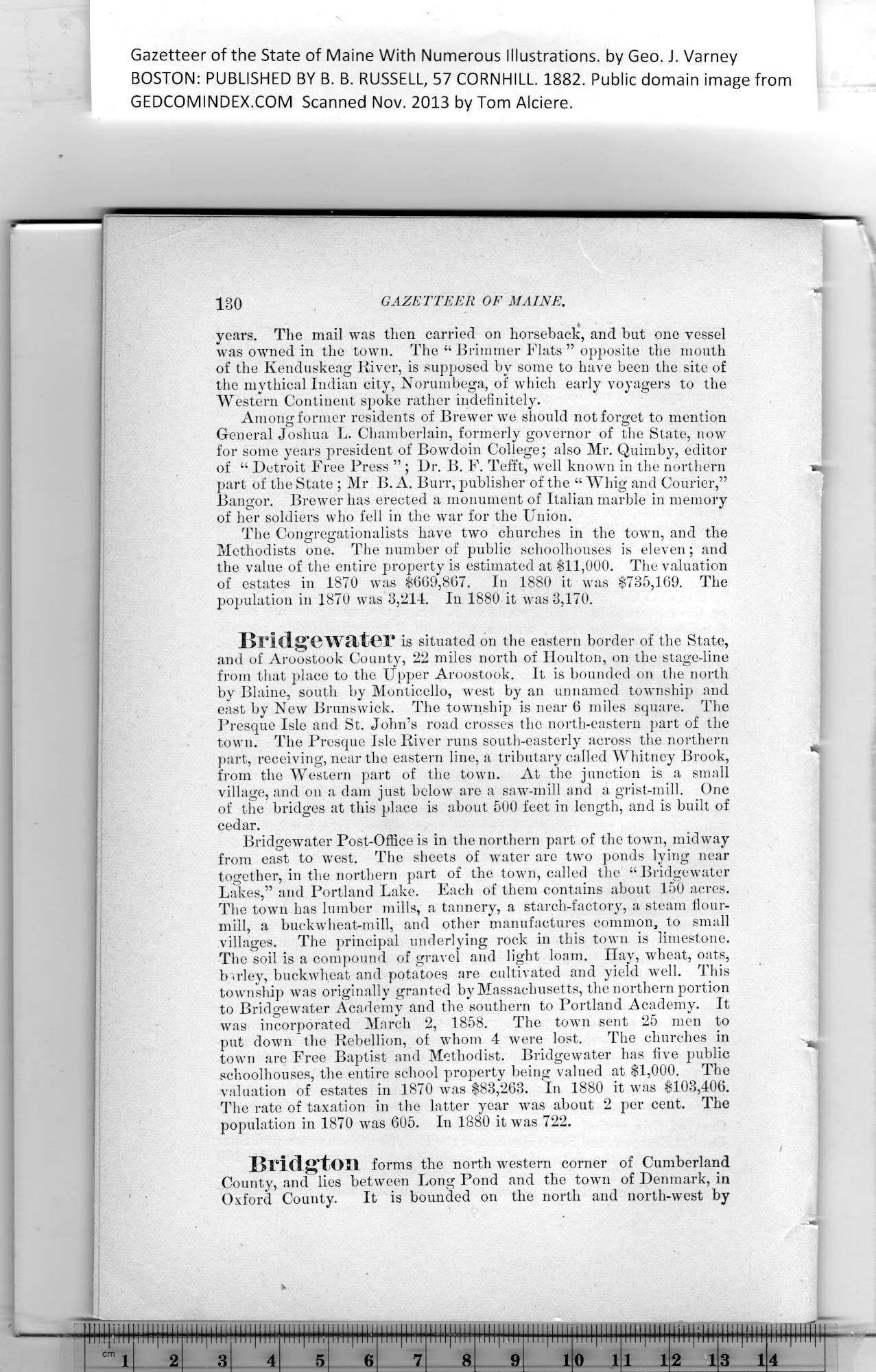|
Gazetteer of the State of Maine With Numerous Illustrations, by Geo. J. Varney
BOSTON: PUBLISHED BY B. B. RUSSELL, 57 CORNHILL. 1882. Public domain image from
130 GAZETTEER OF MAINE.
years. The mail was then carried on horseback, and but one vessel
was owned in the town. The “ Brimmer Flats ” opposite the mouth
of the Kenduskeag River, is supposed bv some to have been the site of
the mythical Indian city, Norumbega, of which early voyagers to the
Western Continent spoke rather indefinitely.
Among former residents of Brewer we should not forget to mention
General Joshua L. Chamberlain, formerly governor of the State, now
for some years president of Bowdoin College; also Mr. Quimby, editor
of “ Detroit Free Press ” ; Dr. B. F. Tefft, wTell known in the northern
part of the State ; Mr B. A. Burr, publisher of the “ Whig and Courier,”
Bangor. Brewer has erected a monument of Italian marble in memory
of her soldiers who fell in the war for the Union.
The Congregationalists have two churches in the town, and the
Methodists one. The number of public schoolhouses is eleven; and
the value of the entire property is estimated at $11,000. The valuation
of estates in 1870 was $669,867. In 1880 it was $735,169. The
population in 1870 was 3,214. In 1880 it was 3,170.
Bridgewater is situated on the eastern border of the State,
and of Aroostook County, 22 miles north of Houlton, on the stage-line
from that place to the Upper Aroostook. It is bounded on the north
by Blaine, south by Monticello, west by an unnamed township and
east by New Brunswick. The township is near 6 miles square. The
Presque Isle and St. John’s road crosses the north-eastern part of the
town. The Presque Isle River runs south-easterly across the northern
part, receiving, near the eastern line, a tributary called Whitney Brook,
from the Western part of the town. At the junction is a small
village, and on a dam just below are a saw-mill and a grist-mill. One
of the bridges at this place is about 500 feet in length, and is built of
cedar.
Bridgewater Post-Office is in the northern part of the town, midway
from east to west. The sheets of water are two ponds lying near
together, in the northern part of the town, called the “Bridgewater
Lakes,” and Portland Lake. Each of them contains about 150 acres.
The town has lumber mills, a tannery, a starch-factory, a steam flour-
mill, a buckwheat-mill, and other manufactures common, to small
villages. The principal underlying rock in this town is limestone.
The soil is a compound of gravel and light loam. Hay, wheat, oats,
hurley, buckwheat and potatoes are cultivated and yield well. This
township was originally granted hy Massachusetts, the northern portion
to Bridgewater Academy and the southern to Portland Academy. It
was incorporated March 2, 1858. The town sent 25 men to
put down the Rebellion, of whom 4 were lost. The churches in
town are Free Baptist and Methodist. Bridgewater has five public
schoolhouses, the entire school property being valued at $1,000. The
valuation of estates in 1870 was $83,263. In 1880 it was $103,406.
The rate of taxation in the latter year was about 2 per cent. The
population in 1870 was 605. In 1880 it was 722.
Bridgton forms the north western corner of Cumberland
County, and lies between Long Pond and the town of Denmark, in
Oxford County. It is bounded on the north and north-west by
PREVIOUS PAGE ... NEXT PAGE
This page was written in HTML using a program written in Python 3.2
|
